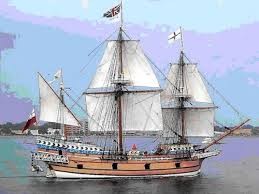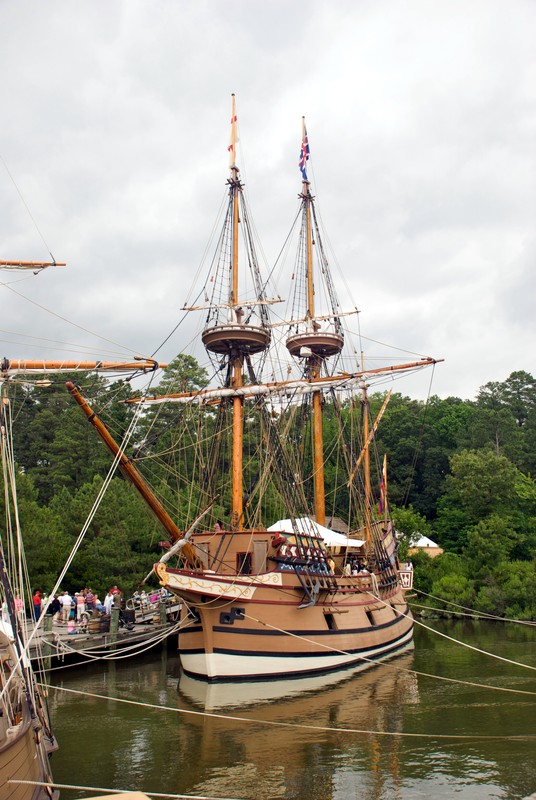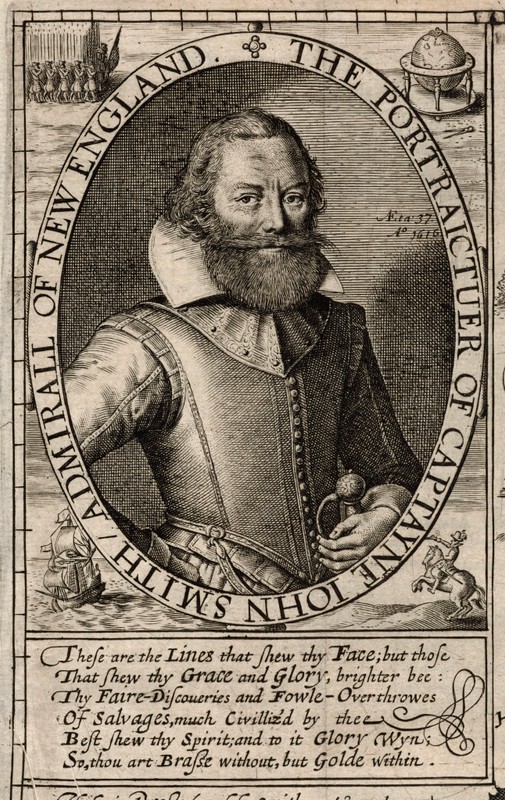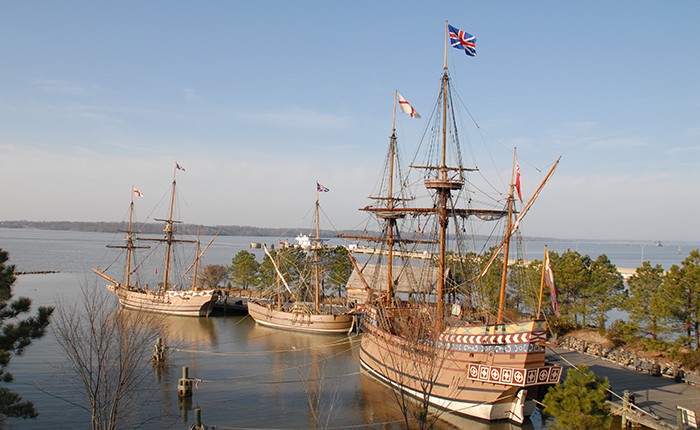Replica of The Susan Constant, Godspeed, and Discovery
Introduction
Text-to-speech Audio
Images
Original portrait of the Susan Constant, one of the three vessels leading to the founding of the Jamestown Colony.

Replica ship Susan Constant in port at Jamestown Settlement by Warfieldian on Wikimedia Commons (CC BY-SA 3.0)

Engraving of Captain John Smith, in his book "The Generall Historie of Virginia, New England, and the Summer Isles," 1624 (public domain)

Jamestown Settlement Ship replicas, courtesy of Jamestown Settlement & American Revolution Museum at Yorktown (reproduced under Fair Use)

Backstory and Context
Text-to-speech Audio
Three Virginia Company ships sailed from London on December 20, 1606, carrying 105 passengers and 39 crew members. The largest of the ships, the Susan Constant or Sarah Constant (116'), carried 71 people; the Godspeed (88'), captained by Bartolomew Gosnold, carried 52; the pinnace Discovery (66'), captained by John Ratcliffe, carried 21. The Susan Constant had been built in London in 1605 and was leased Dapper, Wheatley, Colthurst and Partners. The ships sat in the English channel for weeks waiting for favorable winds. The leader of the voyage was Captain Christopher Newport, a British sea captain who "was elevated to the rank of principal master of the Royal Navy in 1606, the same year that he was chosen by the Virginia Company to lead a colonizing mission to the New World" (Albert, 2016). The fleet entered Virginia's Chesapeake Bay in April of 1607.
Upon arrival, Newport was named one of the seven-person government of the settlement, named Jamestown for King James I and established on May 13, 1607. Between 1606 and 1611, Newport led a total of five voyages between Virginia and England, bringing supplies and additional settlers back to the fledgling colony (Albert, 2016). Once Newport led the colonists back to England to report to King James, those left behind suffered greatly from hunger and illness, as well as the constant threat of attack by members of local Algonquian tribes, most of which were organized under Chief Powhatan. "An understanding reached between Powhatan and John Smith led the settlers to establish much-needed trade with Powhatan’s tribe by early 1608" (History.com, 2012).
Accused of mutiny during the settling of Jamestown, John Smith was imprisoned on the Susan Constant. According to sources, he was able to communicate with some of the ship's passengers along the voyages to Jamestown. On June 10th, Smith was finally released from the first prison of Virginia aboard the Susan Constant. Soon after, Smith was part of the effort to overthrow colony president Edward Wingfield (biography.com, 2014). After a new group of settlers arrived in 1610, tobacco became Virginia’s first profitable export, and a period of peace followed the marriage of colonist John Rolfe to Pocahontas, the daughter of an Algonquian chief Powhatan. King James I dissolved the Virginia Company and made Virginia into an official crown colony, with Jamestown as its capital, in 1624 (History.com, 2010).
After the initial settlement, the Susan Constant and The Godspeed made several more trips between Jamestown and England in the service of the Virginia Company. Afterward, they made have returned to service as colliers, or ships for transporting coal. The Discovery was purchased by the Muscovy Company and continued to trade around Virginia, and the last mention of it was around 1611.
The Commonwealth of Virginia financed $2.14 million for the creation of a replica of the Susan Constant. The production of the replica, completed in 1991, was led by Robert G.C. Fee, the Naval Architect for the Newport News Shipbuilding Company. Valuable information on the original Susan Constant's dimensions came from court documents detailed a minor collision between the ship and another on the River Thames. The Susan Constant replica sailed around Chesapeake Bay in 2007 as part of the Jamestown settlement's 400th anniversary celebrations.
A replica of the Godspeed was built between 2004 and 2006, and a replica of the Discovery followed in 2007. The Virginia General Assembly declared the three replicas the "official fleet of the Commonwealth."
Sources
Albert, Melissa. Christopher Newport: British Sea Captain. Encyclopedia Britannica. August 03, 2016. Accessed November 15, 2017. https://www.britannica.com/biography/Christopher-Newport.
Biography. John Smith. Biography.com. November 10, 2014. Accessed November 15, 2017. https://www.biography.com/people/john-smith-9486928.
Coughlin, Bill. Discovery, Historical Marker Database. June 16th 2016. Accessed March 15th 2020. https://www.hmdb.org/m.asp?m=40253.
Coughlin, Bill. Godspeed, Historical Marker Database. June 16th 2016. Accessed March 15th 2020. https://www.hmdb.org/m.asp?m=40254.
Coughlin, Bill. Susan Constant, Historical Marker Database. June 16th 2016. Accessed March 15th 2020. https://www.hmdb.org/m.asp?m=40252.
History.com. Jamestown Colony. 2010. Accessed November 15, 2017. http://www.history.com/topics/jamestown.
Jamestown Settlement & American Revolution Museum at Yorktown. Jamestown Settlement Ships: Susan Constant, Godspeed and Discovery, Jamestown Settlement. Accessed March 15th 2020. https://www.historyisfun.org/jamestown-settlement/jamestown-ships/.
National Park Service. What Happened to the Three Ships?, Historic Jamestowne. February 26th 2015. Accessed March 14th 2020. https://www.nps.gov/jame/learn/historyculture/what-happened-to-the-three-ships.htm.
Smithsonian National Museum of American History. Ship Model, Susan Constant (1998.0227.01), On the Water. Accessed March 15th 2020. https://americanhistory.si.edu/onthewater/collection/1998.0227.01.html.
Wikipedia: The Free Encyclopedia. Susan Constant. Last Edited September 15, 2017. Accessed November 15, 2017. https://en.wikipedia.org/wiki/Susan_Constant.
https://commons.wikimedia.org/wiki/File:JamestownShips.jpg
https://en.wikipedia.org/wiki/John_Smith_(explorer)#/media/File:Houghton_STC_22790_-_Generall_Historie_of_Virginia,_New_England,_and_the_Summer_Isles,_John_Smith.jpg
https://www.historyisfun.org/jamestown-settlement/jamestown-ships/
